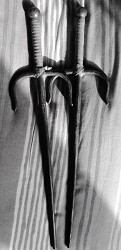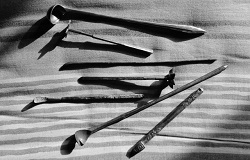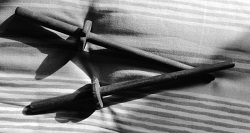Here I’d like to introduce the practice of classical saijutsu on my “Bozooka”. But first, a few words on the sai itself.

A pair of Sai (author’s collection).
During the latter part of the Ryūkyū kingdom, sai were carried by medium to higher level police commissioner called Ufuchiku, who were officials of the royal government. In the chain of command the Ufuchiku were above the Wachichiku and the Chikusaiji, who were usually equipped with a bō. Sai were used to arrest criminals, at court, in prisons, to control crowds, and to guard the king and other dingities. On the other hand, and similar to swords, they served as a sign of authority.
Historically sai were made of iron with three prongs: the middle prong (monouchi) was excessively long and used for blocking, striking, and thrusting, and the crossguard was bend forward on both sides (yoku) so as to protect the hand, to block, to hook etc.
There are various theories as regards the origin of the sai. Similar trident-like weapons existed everywhere in the world throughout history. Similar weapons ecisted in China, where they are said to have been common among magistrates, couriers, and wuguan (military or navy officers). In China a huge number of historical tridents can be verified: the flying fork (feicha), the extra long fork (changcha) and the horse fork (macha), the latter introduced during the Ming ear and used to attack both horses and riders. Various tridents are found in the Jixiao Xinshu (~1560) and in the Wubeizhi (1621) the term wucha is found, literally military or war fork. Most of these forks were attached to poles, though. However, another name of an ancient weapon in the Wubeizhi is tiechi or iron ruler, which is the pronged fork that comes closest to sai.

Kanzashi, ornamental hairpins of old Okinawan culture (author’s collection).
In any case: the character of sai is made up of the two radicals iron and fork. Interestingly, the character for sai also translates to ornamental hairpin (read as kanzashi, see photo on the left). As a further example, in the official report of the investitur of a Ryūkyū king we find that members of the investiture procession on Okinawa were equipped with iron forks (chin.: tiecha) from the royal magazine.
Sai-like weapons are also found all over South and Southeast Asia (see trisula and others). Sai – or the idea thereof – is thought to have entered Okinawa from any of these huge areas at a time still unknown.
Sai also show a strong resemblance to the Japanese jūtte, which was also used by feudal era policemen, but which usually only had one parrying hook; However, looking a bit deeper into historical evidence, forms of jūtte with two parrying hooks indeed existed in feudal Japan, such as can be seen on display at the old customs station of Hakone. Some years ago sai were also discovered during excavations on the premises of an old family of Kumamoto in Kagoshima.
Sai as weapons can be categorized according to their main technical intention and usage. Their technical intention is neither that of cut weapons nor that of a thrust weapons. Sai historically both lack a sharp point and a blade. Their typical characteristic is the blunt impact (as opposed to slashing and stabbing weapons): they are not designed to penetrate or cut open the target. Their main effect is a) that of transmission of the impact force by striking in a circular motion (striking weapon; Schlagwaffe) or b) that of transmission of the impact force by ramming the tip into the target by forward movement (thrust weapon; Stoßwaffe). They can thus be categorized as blunt mêlée weapons used in historical law enforcement in the Ryūkyū kingdom. I prefer to consider saijutsu a system of historical fencing.
In addition, usually one sai is used in each hand. Sometimes a third sai is carried as a replacement in case one is thrown, a method which had been handed down in the Kata called Kogusuku no Sai.

A pair of unique old Sai from Okinawa – there seem to have been various forms (author’s collection).
It is their bladeless design that allows for the characteristic techniques of saijutsu. For example, there are three different gripping methods. Furthermore, it allows the use of the bended crossguard not only as a handprotection and clamp against an incoming weapon, but also to hook, pull, entangle etc. Finally it allows any left-right combination of gripping method and technique. This makes sai a very versatile weapon. It is especially well designed to “bear double” larger weapons and for a huge variety of fast block and counter combinations.
As demonstrated in my article on Hama Higa no Sai – but also simply by researching the existing kata of saijutsu – it becomes obvious that sai are among the oldest weapons classified in kata in Okinawan kobudō. In addition there are other forms of sai, like the manji sai, which looks similar to the Buddhist manji symbol. Further the so called nunti sai, which are often attached to a long stick to became the nunti-bō.
In the video I am using regular sai from world-famous Okinawan brand SHUREIDO. Although without the formal habits and the uniform, handling and techniques applied here are all from classical koryū kata, including Kogusuku no Sai, Tawada no Sai, Chatan Yara no Sai, Hama Higa no Sai, Hama Udun Yakā no Sai, and Tsuken Kōura’gwa Hanta’gwā no Sai. Main techniques are strikes, blocks, thrusts, pulling in, entangles, throws and the like as well as both honte– and gyakute-mochi. I also included a technique I adapted from comparative studies; when you know the above kata you will recognize it right away.
Enjoy, and happy training.
© 2015, Andreas Quast. All rights reserved.
